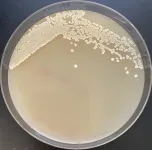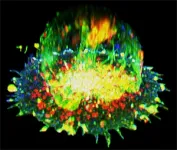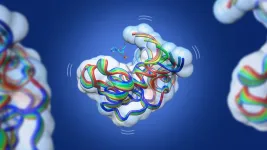(Press-News.org) A research team led by Lawrence Berkeley National Laboratory (Berkeley Lab) and UC Berkeley has engineered bacteria to produce new-to-nature carbon products that could provide a powerful route to sustainable biochemicals.
The advance – which was recently announced in the journal Nature – uses bacteria to combine natural enzymatic reactions with a new-to-nature reaction called the “carbene transfer reaction.” This work could also one day help reduce industrial emissions because it offers sustainable alternatives to chemical manufacturing processes that typically rely on fossil fuels.
“What we showed in this paper is that we can synthesize everything in this reaction – from natural enzymes to carbenes – inside the bacterial cell. All you need to add is sugar and the cells do the rest,” said Jay Keasling, a principal investigator of the study and CEO of the Department of Energy’s Joint BioEnergy Institute (JBEI).
Carbenes are highly reactive carbon-based chemicals that can be used in many different types of reactions. For decades, scientists have wanted to use carbene reactions in the manufacturing of fuels and chemicals, and in drug discovery and synthesis.
But these carbene processes could only be carried out in small batches via test tubes and required expensive chemical substances to drive the reaction.
In the new study, the researchers replaced expensive chemical reactants with natural products that can be produced by an engineered strain of the bacteria Streptomyces. Because the bacteria use sugar to produce chemical products through cellular metabolism, “this work enables us to perform the carbene chemistry without toxic solvents or toxic gases typically used in chemical synthesis,” said first author Jing Huang, a Berkeley Lab postdoctoral researcher in the Keasling Lab. “This biological process is much more environmentally friendly than the way chemicals are synthesized today,” Huang said.
During experiments at JBEI, the researchers observed the engineered bacterium as it metabolized and converted sugars into the carbene precursor and the alkene substrate. The bacterium also expressed an evolved P450 enzyme that used those chemicals to produce cyclopropanes, high-energy molecules that could potentially be used in the sustainable production of novel bioactive compounds and advanced biofuels. “We can now perform these interesting reactions inside the bacterial cell. The cells produce all of the reagents and the cofactors, which means that you can scale this reaction to very large scales” for mass manufacturing, Keasling said.
Recruiting bacteria to synthesize chemicals could also play an integral role in reducing carbon emissions, Huang said. According to other Berkeley Lab researchers, close to 50% of greenhouse gas emissions come from the production of chemicals, iron and steel, and cement. Limiting global warming to 1.5 degrees Celsius above pre-industrial levels will require severely cutting greenhouse gas emissions in half by 2030, says a recent report by the Intergovernmental Panel on Climate Change.
Huang said that while this fully integrated system can be envisioned for a large number of carbene donor molecules and alkene substrates, it is not yet ready for commercialization.
“For every new advance, someone needs to take the first step. And in science, it can take years before you succeed. But you have to keep trying – we can’t afford to give up. I hope our work will inspire others to continue searching for greener, sustainable biomanufacturing solutions,” Huang said.
This work was supported by the DOE Office of Science and DOE Office of Biological and Environmental Research. Additional support was provided by the National Science Foundation.
###
Founded in 1931 on the belief that the biggest scientific challenges are best addressed by teams, Lawrence Berkeley National Laboratory and its scientists have been recognized with 16 Nobel Prizes. Today, Berkeley Lab researchers develop sustainable energy and environmental solutions, create useful new materials, advance the frontiers of computing, and probe the mysteries of life, matter, and the universe. Scientists from around the world rely on the Lab’s facilities for their own discovery science. Berkeley Lab is a multiprogram national laboratory, managed by the University of California for the U.S. Department of Energy’s Office of Science.
DOE’s Office of Science is the single largest supporter of basic research in the physical sciences in the United States, and is working to address some of the most pressing challenges of our time. For more information, please visit energy.gov/science.
END
In a new study in Nature Machine Intelligence*, researchers Bojian Yin and Sander Bohté from the HBP partner Dutch National Research Institute for Mathematics and Computer Science (CWI) demonstrate a significant step towards artificial intelligence that can be used in local devices like smartphones and in VR-like applications, while protecting privacy. They show how brain-like neurons combined with novel learning methods enable training fast and energy-efficient spiking neural networks on a large scale. Potential applications range from wearable AI to speech recognition and Augmented Reality.
While modern artificial neural ...
What cell types are found in which human tissue, and where? Which genes are active in the individual cells, and which proteins are found there? Answers to these questions and more are to be provided by a specialised atlas – in particular how the different tissues form during embryonic development and what causes diseases. In creating this atlas, researchers aim to map not only tissue directly isolated from humans, but also structures called organoids. These are three-dimensional clumps of tissue that are cultivated in the laboratory and develop in a way similar ...
JMIR Bioinformatics and Biotechnology and JMIR Publications are thrilled to announce and welcome Dr Ece Uzun as Editor-in-Chief for JMIR Bioinformatics and Biotechnology.
Dr. Uzun is currently the Director of Clinical Bioinformatics and Associate Director of Clinical Cancer Informatics and Data Science (CCIDS) at Lifespan and an Assistant Professor of Pathology and Laboratory Medicine at Brown University Alpert Medical School. She has a B.S in Chemical Engineering and M.Sc in Biological Sciences and Bioengineering. She completed her PhD in Chemical Engineering at Northeastern University in 2010 and focused ...
Professor Nicolas Doucet and his team at Institut national de la recherche scientifique (INRS) made a major breakthrough earlier this year in the field of evolutionary conservation of molecular dynamics in enzymes. Their work, published in the journal Structure, points to potential applications in health, including the development of new drugs to treat serious diseases such as cancer or to counter antibiotic resistance.
As a researcher specializing in protein dynamics, Professor Doucet is captivated by things that are invisible to the naked eye, yet full of mysteries and essential to all forms of life. He studies proteins ...
Because we don’t have crystal balls to show us how the world used to look, scientists must rely on preserved artifacts and specimens to provide the details. Below are some recent papers published in ACS journals that have unearthed insights from historic items and provided suggestions for protecting relics. Reporters can request free access to these papers by emailing newsroom@acs.org.
“Two Pathways for the Degradation of Orpiment Pigment (As2S3) Found in Paintings”
Journal of the American Chemical Society
April 14, 2023
Oil paintings created before the 19th century often ...
Globally, air pollution is a major public health hazard. A key air pollutant linked to health risks is ambient fine particulate matter (PM2.5), which consists of minute particles, sized less than or equal to 2.5 μm, suspended in the air. According to the WHO, annual PM2.5 levels should not exceed 5 μg/m3. However, the current PM2.5 levels in China far exceed this standard and are responsible for approximately 1.4 million PM2.5-related excess deaths annually. Even as the country steadily works towards reducing ...
(Boston)—The quality of surgery can drastically influence both short- and long-term postoperative outcomes and is a crucial consideration in studies that assess surgical outcomes. One approach for developing accurate quality measures is benchmarking, a quality-improvement process in which the best possible outcomes are identified to serve as a point of reference against which performance can be compared.
Surgery for gallbladder cancer (GBC) is a technically challenging surgical procedure and requires considerable expertise ...
It’s often risky to introduce new products to the market. In fact, statistics show that between 40 to 90 percent of new products fail. A key component of product adoption is consumer psychology. While there are a few theories that attempt to explain why certain people are not likely to accept novelties, a new study takes a slightly different approach.
Florida Atlantic University and collaborators developed and introduced a new mathematical innovation model, grounded in psychology, to provide both qualitative and quantitative predictions of adoption trends for new products.
The objective of the study ...
The experience of the jihadist terrorist attacks that plagued Western Europe between 2015 and 2017 shows that perceived threats from ethnic and religious minorities affect the tone of public discourse about immigration and the support for radical right parties, according to a new study which uses German data, including more than 10mln tweets.
In that period, terrorist attacks and instances of crime involving minorities made immigration a more salient issue for voters, explain Bocconi scholars Francesco Giavazzi (Bocconi University, Milan) and Gaia Rubera (Bocconi ...
CLEVELAND, Ohio (May 8, 2023)—As the population continues to age, there is greater focus on bone health and minimizing fractures to maintain mobility. A new study suggests that various types of hormone therapies not only increase lumbar spine bone mineral density (BMD) in postmenopausal women but also protect against bone loss, even after hormones have been discontinued. Study results are published online in Menopause, the journal of The North American Menopause Society (NAMS).
Osteoporosis is a common debilitating condition, ...







